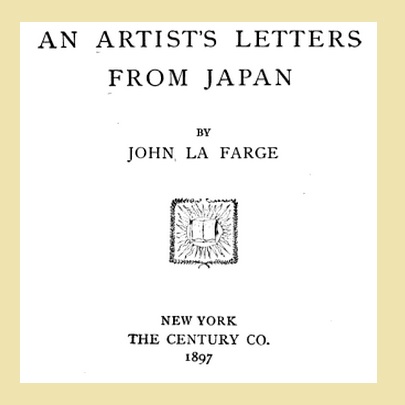
 |
JOHN La FARGE - JAPAN, CAVE MAN, and WINSLOW HOMER |
Three thousand years ago Europe was so, with paganism - the peasant or earth belief -- gradually lost to our comprehension except through hearsay. So we are accustomed to write of the sacred grove; and here it is, all about me, as if history were made living. The lovely scenery reminds me continually of what has been associated with it; a civilization which has been born of it, has never separated from nature, has its religion, its art, and its historic associations entangled with all natural manifestations. The great Pan might still be living here, in a state of the world which has sanctified trees and groves, and associated the spirit-world with every form of the earthly dwelling-place. I feel as if I were nearer than I can be through books to the old world we try to rebuild by collation of facts and documents.La Farge is talking about "spiritual beings, visible even to the eye." While La Farge points out that this kind of seeing was common in ancient times, it is also the kind of seeing that Welles, Allston, Channing, Dana, Bryant*, Longfellow**, and Lowell*** had written about -- the visual perception of things not physically present, but suggested by forms in Nature, spiritual images. Lowell lamented in his poem The Foot Path, published in The Atlantic Monthly August 1868, that this visual experience was going out of fashion.
Could a Greek come back here he would find his "soul-informed rocks," and all that he thought divine or superstitious, even to the very "impressions of Aphrodite." The sacredness that lives here in mountains would seem all natural to him, as would the stories of mountain gods who ages ago met here the advance of Buddhist priests. For Buddhism has joined with the earthly faith in attaching religious value to solitary places and mountain heights, and many are the stories which link these two beliefs from the early times. As, for instance, when Shodo Shonin in his wanderings came here and "opened up" the mountains of Nikko. For this saintly discoverer, dwelling in early youth among sacred caves, and a devout reverer of the native and Buddhist deities, had long dreamed of wondrous things on distant mountains, of celestial or spiritual beings, visible even to the eye, and pursued his search according to holy vows and under celestial guidance. [La Farge, Artist's Letters, page 113]
Through all these thousands and thousands of years I go back and feel that, after all, the only one who has drawn as distinctly and as well, with that firmness of touch, that far down feeling of nature is perhaps derived from such ancestry but happens to have been born on the fierce wave-beaten coast of New England, and the only man who has ever drawn exactly upon the lines of the dwellers with the cave-bear is a great American painter, as great as any in the world, Winslow Homer.La Farge summary
Winslow Homer was a great American painter, as great as any in the world, who could draw with minimal detail, see spiritual beings, and who had a far down feeling of nature.La Farge's primal man saw the same kind of imagined illusion, aka pareidolia, that Washington Allston, Benjamin Welles, William Ellery Channing, Richard Henry Dana Sr., William Cullen Bryant, and Longfellow wrote about.
For this saintly discoverer, dwelling in early youth among sacred caves, and a devout reverer of the native and Buddhist deities, had long dreamed of wondrous things on distant mountains, of celestial or spiritual beings, visible even to the eye, and pursued his search according to holy vows and under celestial guidance.Welles wrote,
It is purely spiritual, because it is produced by the perceptions of the mind, of what is abstractly beautiful, and it is rapturous in that sympathy which rebounds from the coincidence of natural and ideal beauty.And this,
...catch the bright forms of departed friends in the white clouds which wave over the moon.
The constant action of thought in retirement, adds another charm to it. The mind here is not left merely to its own operation, reasoning on subjects of its own suggestion, without the standard of perceptible truth for the conclusion of such abstractions.